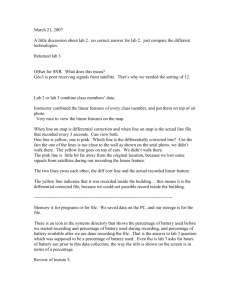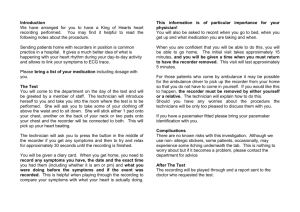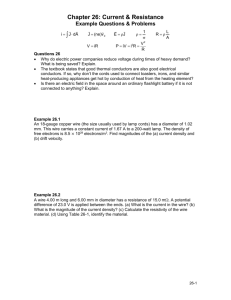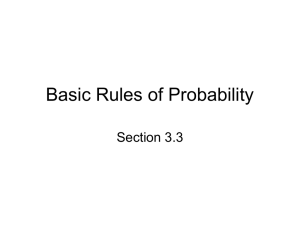A Portable Station for Recording Fire
advertisement
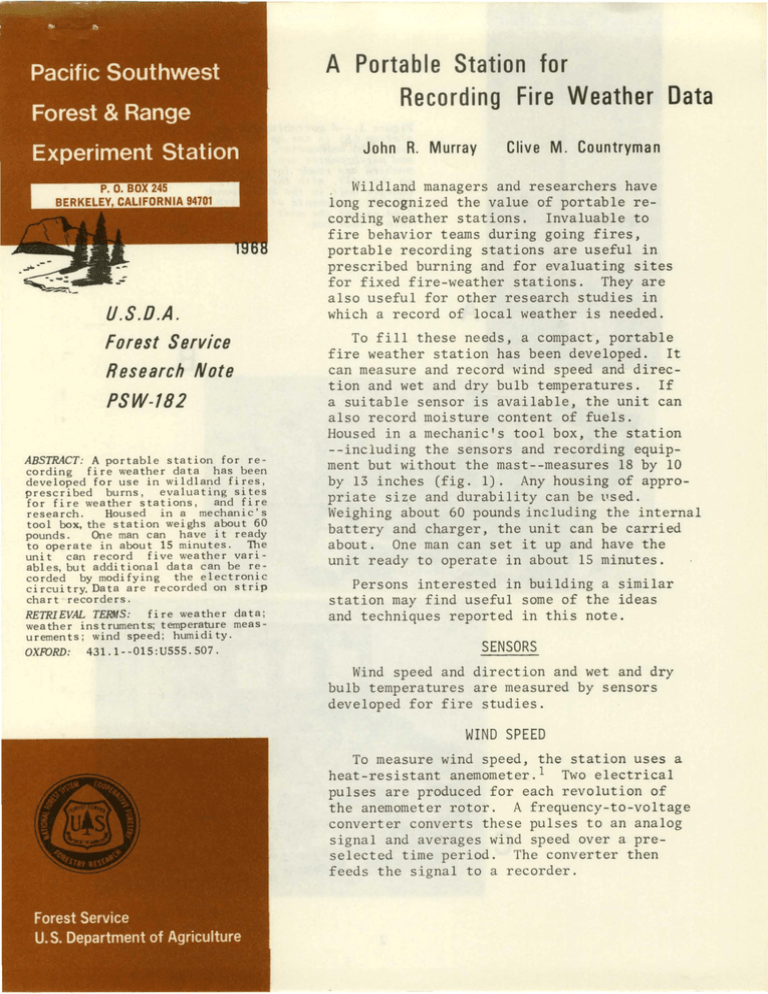
A Portable Station for
Recording Fire Weather Data
John R. Murray
U.S.O.A.
Forest Service
Research Note
PSW-182
ABSTRACT: A portable station for recording fire weather data has been
developed for use in wildland fir e s ,
prescribed burns, evaluating sites
for fire weather stations, and fire
research.
Housed in a mechanic's
tool box, the station weighs about 60
pounds.
One man can have it ready
to operate in about 15 minutes. The
unit can record five weather vari ables, but additional data can be recorded by modifying the electron~c
circuitry. Data are recorded on str1p
chart recorders.
RETRIEVAL TERMS: fire weather data;
weather instruments; temperature measurements ; wind speed ; humidity .
OXFORD:
431.1--01S:USSS.507.
Clive M. Countryman
. Wildland managers and researchers have
long recognized the value of portable recording weather stations. Invaluable to
fire behavior teams during going fires ,
portable recording stations are useful in
prescribed burning and for evaluating sites
for fixed fire-weather stations. They are
also useful for other research studies in
which a record of local weather is needed.
To fill these needs, a compact·, portable
fire weather station has been developed. It
can measure and record wind speed and direction and wet and dry bulb temperatures. If
a suitable sensor is available, the unit can
also record moisture content of fuels.
Housed in a mechanic's tool box, the station
--including the sensors and recording equipment but without the mast--measures 18 by 10
by 13 inches (fig. 1). Any housing of appropriate size and durability can be Psed.
Weighing about 60 pounds including the internal
battery and charger, the unit can be carried
about. One man can set it up and have the
unit ready to operate in about 15 minutes.
Persons interested in building a similar
station may find useful some of the ideas
and techniques reported in this note .
SENSORS
Wind speed and direction and wet and dry
bulb temperatures are measured by sensors
developed for fire studies.
WIND SPEED
To measure wind speed, the station uses a
heat-resistant anemometer. 1 Two electrical
pulses are produced for each revolution of
the anemometer rotor. A frequency-to-voltage
converter converts these pulses to an analog
signal and averages wind speed over a preselected time period. The converter then
feeds the signal to a recorder.
Figure 1.--A portable weather
station (A) is set up for operation; (B) anemometer, wind vane,
and psychrometer are shown assembled and ready for mounting
on the mast, wi th the battery
charger unit in the background;
(C) all components of the station exc ept the mast can fit
into a tool box.
B
:;;:;;? .• •
c
2
To average wind speed, the user can
manually select any one of the three
time periods provided--lS seconds, 2
minutes, 10 minutes--by flipping a
switch on the control panel . The ISsecond period permits recording detailed wind speed structure, including small gusts and peak wind speeds .
The 2-minute time period smooths out
some of the short-term speed fluctuat1ons, but still leaves considerable
detail . The 10-minute period provides a measure of average wind
speed, but does not show the finer
deta1l of w1nd speed structure.
Besides recording wind speed continuously at the selected averaging
interval, the station can record it
at 6-, 12-, 30-, or 60-minute intervals . The user selects the time interval by flipping a switch on the
control panel to set an electric
clock built into the control circuitry . Peak w1nd speed that can
be recorded is 70 miles per hour.
The recorder trace can be read to the
nearest mile .
WIND DIRECTION
The station's w1nd direction transmitter cons i sts of a linear potent1ometer with a 3S0° winding . The potentiometer is placed in a weather-proof
housing and mechanically coupled to a
wind vane . Output from the potentiometer is fed directly to this recorder
through appropriate range control circuitry . To insure accuracy of wind
direction readings the voltage supply
to the potentiometer 1s regulated to
0 . 01 percent per °C. The recording
interval switch also controls the wind
direction recording so that wind direction is obtained at the same real time
as wind speed. The wind d1rection recorder trace can be read in about 7°
increments.
WET AND DRY BULB TEMPERATURE
a radiation sh1eld . One thermistor is
covered with a cotton wick kept moist
by means of a water reservoir . An
electric fan at the top of the radiation shield draws air over both thermistors . To reduce any effect of water
temperature on the wet bulb temperature,
a portion of the wick dnwnstream from
the th er mistor is left exposed to the
aspirating a ir stream.
The psychrometer takes 60 seconds
to record. During the first 20 seconds, the thermistors are asp i rated to
bring them to ambient air conditions .
The dry bulb temperature then records
for 20 seconds, followed by a 20-second
recording of the wet bulb temperature.
The aspirating fan lS then shut off
and the recorder chart allowed to run
for 30 seconds to provide a separation
on the chart between read-outs .
The recording-time interval switch
also controls the psychrometer readout,
permitting temperature readings at 6-,
12-, 30-, or 60-minute intervals . In continuous recording mode, temperature
read1ngs are 90 seconds apart . To
provide better resolution on the narrow
recording chart, two overlapping temperature ranges are prov1ded. One range
covers temperatures between 20°F. and
80 °F . , and the other range S0°F. to
ll0°F. The range used is controlled
by a manual switch on the control panel.
Temperature to the nearest °F. can be
read from the recorder trace.
RECORDERS
Data are recorded by three Rustrac
strip chart recorders with SO microampere meter movements. A clapper bar
depresses the meter pointer every 2
seconds to mark the pressure-sensitive
paper. This type of recording eliminates the problems of pens clogging in
dry weather and spilled ink in transport--common to inking-type recorders.
Wind speed and direction are recorded on separate recorders. The
charts on these two recorders are chronometrically driven to give time synchron ization between wind speed and direction
An aspirated, thermistor psychrometer is used to measure wet and dry
bulb temperatures . 2 It consists of a
pair of matched thermistors housed in
-3-
j
IN537 2N539
~
'I
Psychrometer
Fan Motor
470·2,
2.2K
ON-OFF
I A Fuse
Batt ery
25- 36v.
Battery I~est
I N537
-~
sw
L
I ~
~We!
Dry
~
3 .GK
_._
""'r
IN537
Turn-on tor continuous wind speed 8
direction recordin g
~
IN537
I .~697
G.SK
~
"
"tp"1>
¥
I
~
~Wind
~ direction
Wind
Jspeed
~ Recorder chart
2NG97
9-
61
-:r
IN537
drive motors
+Reg. volts
1
~
15 v.
;--
fl
.0
..-JIN943
G.SK
"
'--
<
0
r
~~
q}!Manual
start
I-
)t
'r--JIN702
220
470-"'.
y
<ny;
47K
.lut
T 470-"'.
2N949
'I
2 . 2K
680..1'\..
Hl-
Min .
~
Clack
~
l
s-
1.2K
1230-
IK
.o s~'-.OOI
1
IK
r-:5~
GO-
9.1K
~
2NG97
t-
IOK
IN914
I
u3.GV
lOOK
27K
1111914
1.2K
1111914
Y2N949
IK
17~
-
11113.69
G.SK
21111303
v
220
..n.
f--J
3.GK
'~
to
2N2G41
.._
"'
170uf
47K
50K
IN914
FL
~,~'"
1.5K
--
,05
IOK
iL---'
f------', -
.br--
2.2K
1. 5K
6,8K
~
1111914
[
--'
~
2111130'3
l
27K
~
IOK
IN914
y
1.2K
.05
1.5K
21111303
Figure 2. --(A) Control circuitry of the portabl e wea th e r station;
4
~
'12111949
2 . 2K
Note :
All points marked ~ are
returned to battery negative
,s
1111914
Relay Coil s
IOOOohm s
6.3 MA
1.2K
'~2111949
G.SK ~
o.AA. ~111697
r-
IN914
y
27K
lut
h.50MHJ
El
RL3¢
Anemometer
contacts
6.8K
47K
+
4.7
IN949
12K
uf
9,1
K
TM Y<1
IK
L4:.:.·7:...:u:..;.f_-f
1-----i ..
Temp.
camp.
Psychrometer
calibration
500..n...
9.1K
L
482
375
..J\..
..J\..
900uf
.....q,.+_,_ __
~-
Psychrometer recorder
400uf
To wet 8 dry bulb or zero
reference relays
To wet 8 dry bulb bridge
Wind
direction
calibration
Wind speed
recorder
47K
RL 1
Wind direction IN914
recorder ~
tJ
'-----
I
I
Dry bulb
I
I
~
temperature
sensor
Wind direction
potentiometer
!Relay c?ils show~
Lon prev1ous pogej
All recorders ore 50uo, 5000 ohm Ruslrock
type. The two used for wind speed and direction hove chronometricolly governed motors.
Figur e 2. --(B) bridge circuitry of the portable weather station.
5
A
B
115v, A.C.
Automotive
battery input
-12
y+l2
\ON-OFF
360..1\...
+
400uf,75v
4.7K
IN469
2N859
2.7K
+
IK
1000/50v
34..1\...
4w
.I uf
t40v
2N697
470..1\... 5K
IK
+
200uf50v
1-------lltltlt
34v, 5AH
Nickel Cadmium
Battery
+
• ·sattery to be charged
Battery Charger
{ 12 v. automotive battery
to 34 v. recorder battery)
Figure 3. --Circuitry for the two types of battery charger
for the weather station: (A) a battery charger is built
into the unit and operates on 115 volts A.C.; (B) a power
converter, housed in a separate box, can charge the battery from a 12 -volt automotive battery.
6
..
records. The third recorder is used
to record wet and dry bulb temperatures in sequence. Additional variables can be recorded as · changes are
made in the station.
A chart speed of 10 inches per hour
is used for the recorders, making
possible a 72-hour continuous record
on a 60-foot roll of chart paper. A
longer recor.d ing period is possible if
the station is operated on one of the
time interval modes.
ELECTRONICS
The power converter is housed in a
separate box. The e lectronic circuitry for the recording fire weather station is shown in figure 2. Circuitry
for the battery chargers is shown i n
figure 3.
Besides the necessary controls for
the sensors, a recording mode and
battery condition i ndicator is also
included. A complete readout between
programed recording times can also be
made.
FOOTNOTES
A wet cell battery (26 V., 5AH)
provides sufficient power to operate
the unit for about 5 days. The unit
includes a battery charger designed to
operate on 115 volts A.C. In addition,
a power converter that will charge the
battery in 2 hours from a 12-volt automotive battery was built for use if
115 volt A.C. power was not available.
1
countryman Cllve M
iV!urray John R
Philpot
Charles W An e lectronic fire wea ther station
U S Forest Serv Res Note PSW N17 Pacific
SW Forest a nd Range Exp S ta
Berkeley Calif
8 p
1963
2Murray John R a nd Countr)'man Clive !vi Heat
resistant· anemometers f or fire resear ch U. S
D A Forest Serv Res Note PSW 181 Pacific
SW Forest and Range Exp Sta
Be rkeley Callf
6 p
i llus
1968
The Authors-------------------------------are studying problems 1n mass fires and fire
behav1or . with headquarters a t the Station s
Forest Fire Laboratory Riverside Calif
)Q:.N R lv!URRAY a 1954 fares try graduate of
Purdue University . joined the Station ' s f1re
research staff in 1958
CLIVE M CXXJNTRYMAN
heads fire behavior studies
He e arned B S
degree in forestry at the University of
''Jashington ( 1939) . and joined the Fares t
Service that same ye ar
-7-
